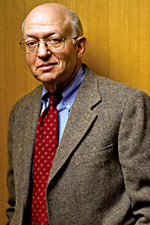January 08, 2014

Directorships over past five years: 2
Total director compensation, 2008-2012: $1,182,399
Average compensation per full year of service as director, 2008-2012: $284,089
Martin Feldstein has long been one of the country’s top conservative economists. He has been an economics professor at Harvard University since 1967. He was president of the National Bureau of Economic Research (NBER) from 1977 to 2008.
Feldstein served as Chairman of President Reagan’s Council of Economic Advisers from 1982 to 1984. In 2006, George W. Bush appointed him to the President’s Foreign Intelligence Advisory Board, where his job was to oversee intelligence gathering and report abuses.. President Obama appointed Feldstein to the President’s Economic Recovery Advisory Board.
In addition to being a leading advocate of lower taxes and reduced government spending, Feldstein has also been a leading proponent of the privatization of Social Security. One of his most important early papers was a 1974 article in the Journal of Political Economy which purported to show that social security leads to a 30-50% reduction in private savings. It later turned out that the paper’s findings were the result of a programming error.
Feldstein was a director of American International Group (AIG) from 1987 through June 2009, a period in which the company was rocked by scandals. In 2005, Maurice Greenberg, who had been the company’s CEO for nearly 4 decades, was forced from his seat after an accounting error came to light: AIG had overstated its income by $3.9 billion over five years. Following the scandal’s fallout, journalists noted that Greenberg appeared to have cultivated an especially loyal relationship with AIG directors by approving sizeable donations from the foundation of which he was chairman to organizations associated with AIG board members. The NBER received over $3 million from Greenberg’s foundation from 1998 to 2005.
Over the two fiscal years before Greenberg’s ouster, in 2003 and 2004, the board approved his compensation at over $53 million, or $67 million in today’s dollars. Greenberg’s successor, Martin Sullivan, steered the company from 2005 to the precipice of the financial meltdown—he resigned in June 2008. The AIG board determined that Sullivan’s departure was for “good reason,” a decision that approved his $47 million severance package.
Less than four months after Sullivan stepped down, AIG was driven to the edge of bankruptcy, having issued hundreds of billions of dollars in credit default swaps which it could not support. It was saved from bankruptcy by a government bailout that required more than $180 billion in loans.
Feldstein also served as a director of the pharmaceutical giant Eli Lilly and Company from 2002 through April 2012. The company significantly underperformed the S&P average from 2004 through Feldstein’s retirement, and performed particularly poorly from the trough of the recession in early 2009 through the end of his term as director. In 2009, probably the company’s worst year under Feldstein’s direction, CEO John Lechleiter’s compensation exceeded $20.9 million, up 60% from the company’s CEO pay in 2007.
Feldstein previously served as a director of HCA Inc., the largest for-profit hospital chain in the U.S., from 1998 through 2006. Feldstein joined the board just after then-CEO and current Florida governor Rick Scott was forced out during investigations into massive Medicare fraud, for which the company was fined $1.7 billion.






